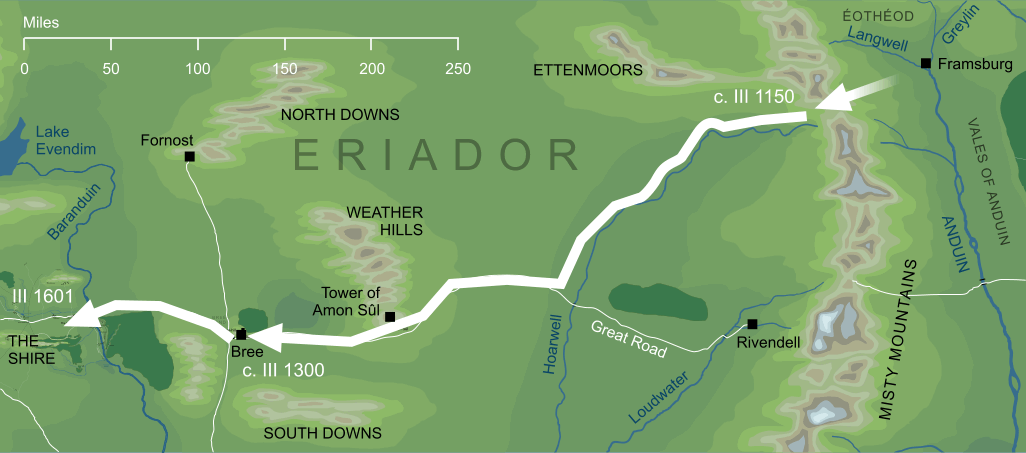
The westward migration of the Fallohides across
Eriador.
The westward migration of the Fallohides across
Eriador.
One of three original divisions of Hobbit-kind, along with the Harfoots and Stoors. The Fallohides were the least numerous of the three branches, and originally dwelt in the northern parts of Middle-earth.
The Nature of the Fallohides
In appearance, Fallohides were taller and slimmer of build than the other Hobbits, with some growing to four feet or more in height. Both their skin and their hair tended to be fair, and no Fallohide ever grew a beard.
Fallohidish culture was much more open to outside influence than that of the Stoors or Harfoots; they were friendlier with the other races of Middle-earth than their cousins, and were especially noted for associating with the Elves. Perhaps because of this, they were skilled in both song and speech.
While the other two branches of Hobbit-kind were pastoral and rustic in nature, the Fallohides retained a hunting tradition, and so were naturally bolder and more inquisitive than their relatives, but less gifted in the arts of farming and agriculture.
The History of the Fallohides
The Fallohides seem to have dwelt originally on the upper reaches of the River Anduin, in the region where the Greylin and the Langwell flowed into the Great River. It is likely that they mixed with the ancestors of the Rohirrim at this time, for the Northmen also dwelt in this region, and this is likely the origin of the legend of the holbytlan found in Rohan.
At the end of the first millennium of the Third Age, evil things began to stir in the east of Middle-earth, and many peoples, including the ancestral Hobbits, began to travel westward across the Misty Mountains. The first Hobbits to enter Eriador were the Harfoots; the Fallohides deserted their northern homes in around III 1150, and crossed the mountains to the north of Rivendell, at the sources of the River Hoarwell.
The tribes of the Fallohidish Hobbits travelled slowly down the course of the Hoarwell, and westward across Eriador. They eventually settled in the region around Bree in about the year III 1300, where their adventurous and intrepid natures made them natural leaders of the other Hobbits they found there. It was presumably at about this time that the three strains of Hobbits began to mix freely for the first time.
Three hundred years later (in the year 1601 of the Third Age), two Fallohide brothers, Marcho and Blanco, travelled westward again from Bree with their followers and crossed the Bridge of Stonebows (later the Brandywine Bridge). They settled in the empty land that they found there and were granted it by King Argeleb II of Arthedain, in whose realm it lay. This was the land that was to become known as the Shire.
As the centuries passed, the three distinct strains of the Hobbits gradually began to disappear as they mingled with one another in the Shire. Nonetheless, there were families that retained a strong line of Fallohidish blood, and the impetuosity that went with it. At the time of the War of the Ring, the Fallohidish line was still well represented in the families of the Tooks and the Brandybucks.
See also...
Bolger Family, Bree, Bree-hobbits, Bridge of Stonebows, Brown Family, Buckland, Bucklanders, Celepharn, Gamgee Family, Harfoots, Hobbits, Holbytlan, Isengar Took, Little Folk, Marcho, [See the full list...]Menegilda Goold, River Anduin, River Hoarwell, Shire-hobbits
Indexes:
About this entry:
- Updated 9 April 2017
- This entry is complete
For acknowledgements and references, see the Disclaimer & Bibliography page.
Original content © copyright Mark Fisher 1998, 2001, 2013, 2017. All rights reserved. For conditions of reuse, see the Site FAQ.

